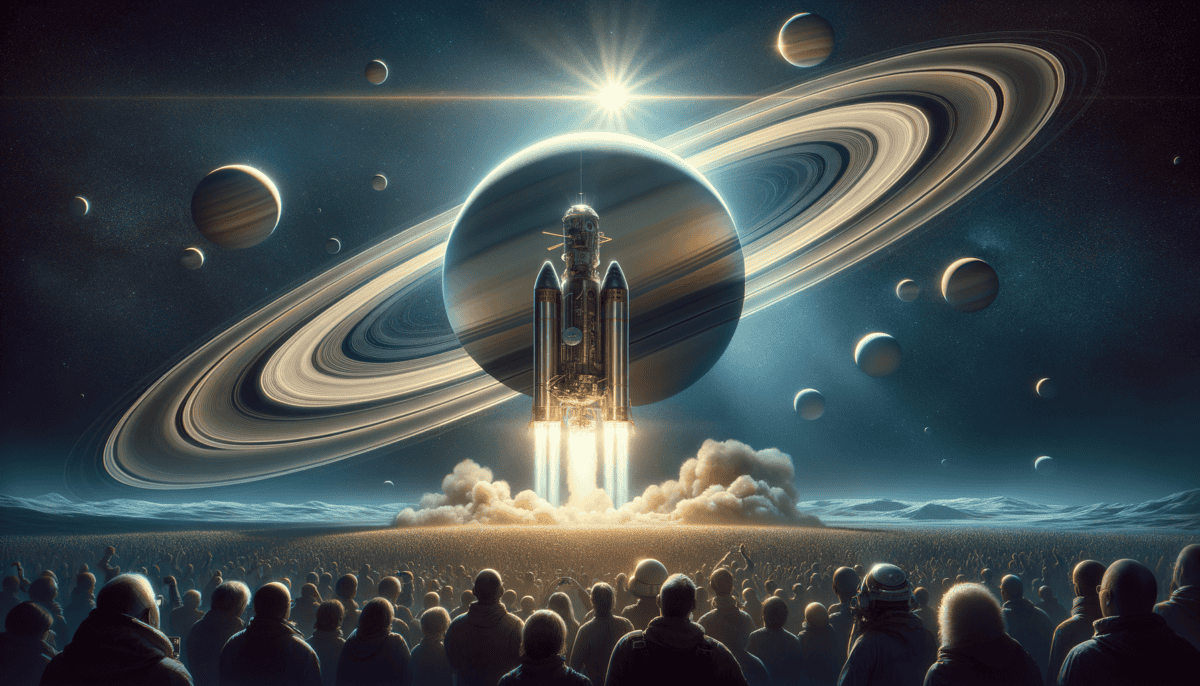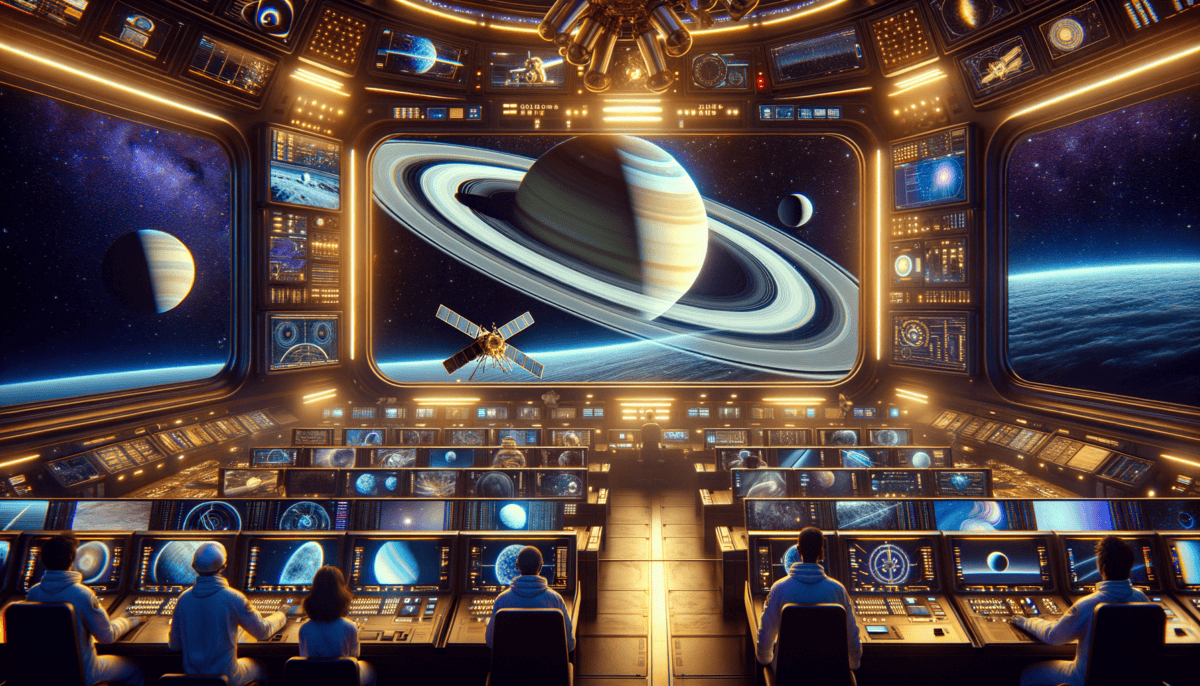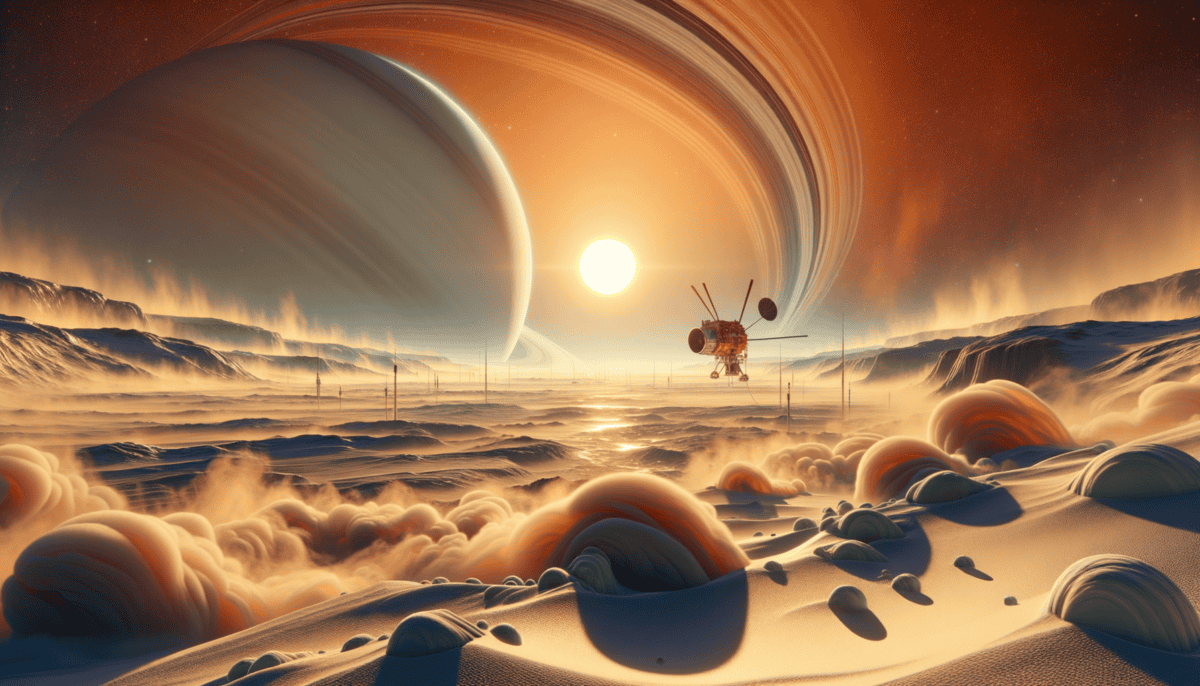The Cosmic Dream
On a bright morning in 1982, Dr. Sarah Chen walked into her office at NASA with a big dream. She wanted to send a special robot to Saturn! The robot would be called Cassini.
“We need to learn about Saturn’s rings and moons,” Dr. Chen told her friend Dr. James Miller. “No one has ever been there before!”
Dr. Miller smiled and nodded. “It’s a great idea! But Saturn is very far away. We’ll need lots of help.”
Dr. Chen knew they needed friends from all over the world to help build Cassini. She called scientists from:
- America
- Europe
- Italy
“Together, we can do this!” she said. Everyone was excited to work together.
Building the Space Robot
Building Cassini was like putting together the biggest puzzle ever! It needed:
Special cameras to take pictures
Antennas to talk to Earth
☀️ Solar panels for power
The team also built a smaller robot called Huygens. It would ride on Cassini and later visit Saturn’s biggest moon, Titan!
“Think about it,” Dr. Miller said. “We’re building something that will fly past Jupiter and go all the way to Saturn. It’s amazing!”
Getting Ready for Launch
It took 15 years to build everything perfect. The scientists checked every wire and tested every part. They wanted to make sure nothing would go wrong in space.
One day, Dr. Chen looked at the finished spacecraft. Tears filled her eyes.
“What’s wrong?” asked Dr. Miller.
“Nothing’s wrong,” she smiled. “I just can’t believe we did it. Our dream is about to fly to Saturn!”
The whole team gathered around Cassini. They had worked so hard. Soon, their space robot would start the longest journey ever. It would teach us new things about Saturn and its beautiful rings.
As the sun set that evening, Dr. Chen looked up at the sky. Somewhere up there, Saturn was waiting. Soon, Cassini would visit this distant planet and show us its secrets. The greatest space adventure was about to begin!
Journey into the Unknown
The big day arrived on October 15, 1997. Cassini sat on top of a giant rocket at Cape Canaveral in Florida. Everyone was super excited!
“Today’s the day our dream takes flight,” whispered Dr. Chen to her team. Her hands were shaking with excitement.
Blast Off!
The countdown began: “10… 9… 8…”
Everyone held their breath.
“3… 2… 1… LIFTOFF!”
WHOOSH! Fire and smoke filled the air. The rocket climbed higher and higher into the sky. Cassini was on its way to space!
The Long Space Road
But getting to Saturn wasn’t easy. Cassini needed to take a special path through space, like a cosmic dance!
First, it flew past:
- Venus (twice!)
- Earth
- Jupiter
“Each planet gives Cassini a little push,” Dr. Miller explained to visiting school kids. “Like when you push someone on a swing to help them go higher!”
Life During the Journey
While Cassini traveled through space, the scientists kept busy. Every day, they:
Checked if Cassini was healthy
️ Made sure all parts worked well
Listened for messages from space
“It’s like taking care of a baby,” laughed Dr. Chen. “A very big, very far away space baby!”
Special Space Mail
Sometimes, Cassini sent pictures back to Earth. The first ones came from Venus and Jupiter. Everyone was amazed!
Seven years passed. The team worked hard every day. They knew Saturn was getting closer and closer.
Almost There!
“Look!” Dr. Miller pointed at a tiny dot in one of Cassini’s pictures. “That’s Saturn! We can see its rings!”
Dr. Chen smiled. “After all these years, we’re finally going to make it.”
The whole team gathered to watch the screens. Cassini was about to show them things no one had ever seen before. Saturn’s beautiful rings and mysterious moons were waiting.
The greatest part of their space adventure was just beginning! ✨
First Glimpse of Saturn
“It’s more beautiful than we ever imagined!” Dr. Chen gasped. On July 1, 2004, Cassini finally reached Saturn. The room filled with happy cheers!
“Look at those rings! They shine like rainbow ribbons in space!” Dr. Miller jumped up and down with joy.
A Closer Look
Cassini sent amazing pictures back to Earth. Saturn’s rings looked like a giant CD in space! But they were made of billions of ice chunks – some as tiny as snowflakes, others as big as houses.
Ring Detective Work
The scientists found some cool stuff about Saturn’s rings:
- They’re super thin – like a giant piece of paper
- They dance and make waves
- Some rings have funny shapes
“The rings are like a story book,” Dr. Chen told her team. “Each ring tells us something new about Saturn!”
Colors in Space
Cassini’s special cameras showed Saturn in different colors:
Golden yellow – from the top
Soft blue – around the edges
Swirling storms – making pretty patterns
“Saturn puts on the best light show in our solar system!” said Dr. Miller.
Storm Watching
One day, Cassini saw something super exciting – a huge storm! It was shaped like a hexagon (that’s a shape with six sides). ⬡
“How can a storm be six-sided?” asked a young student visiting the lab.
“That’s one of Saturn’s many mysteries,” smiled Dr. Chen. “That’s why we’re here – to learn new things!”
Making Maps
Every day, Cassini worked like a space photographer. It took pictures of:
Saturn’s north pole
The south pole
All the space between
“We’re making the first complete map of Saturn,” Dr. Miller explained. “Like drawing a picture of a giant space marble!”
Happy Surprises
Sometimes Cassini found things nobody expected. One day, it spotted tiny moonlets (baby moons) hiding in Saturn’s rings!
“Each day brings something new,” Dr. Chen wrote in her diary. “Saturn is full of wonderful surprises.”
But while Cassini was busy studying Saturn, another part of the mission was getting ready. Soon, a special probe named Huygens would take an amazing journey to Saturn’s biggest moon – Titan!
Landing on Titan’s Secret World
Dr. Chen couldn’t sleep. Tomorrow, the Huygens probe would do something no one had ever done before – land on Titan!
“This is like dropping a beach ball through clouds made of orange juice,” she told her excited team.
The Big Drop
On January 14, 2005, Huygens began its brave journey down to Titan. It fell through thick orange clouds for over two hours!
“It’s sending pictures!” shouted Dr. Miller. Everyone crowded around the screens.
A New World Appears
As Huygens dropped lower, it showed things no one expected:
- Rivers made of liquid methane (like super-cold gasoline)
- Mountains of solid ice
- Rocks scattered everywhere
- Lakes that looked like puddles on Earth
“Titan looks a bit like Earth!” a young scientist gasped. “But everything is frozen and orange!”
Making a Splash
When Huygens finally landed, it made a small splash in soft ground. The surface felt like wet sand mixed with ice cream!
“We just landed on an alien beach,” laughed Dr. Chen. “But don’t try to swim there – it’s -290°F!”
Earth’s Strange Cousin
Scientists found that Titan is like Earth in many ways:
️ It has rain (but it’s methane, not water)
⛰️ It has mountains (but they’re made of ice)
️ It has beaches (but they’re super, super cold)
Special Weather Report
Huygens measured Titan’s weird weather. The winds were strong enough to make waves on the methane lakes!
Underground Secrets
“The ground here might be hiding an ocean of water ice,” Dr. Miller said, pointing to new data. “Like a giant frozen swimming pool under the surface!”
Huygens took pictures and collected information for several hours. Each bit of data told a new story about this strange world.
A Special Place
“Titan is teaching us so much about how planets form,” Dr. Chen said. “It’s like looking at Earth when it was very young.”
The team celebrated their success with space-themed cookies. But while they enjoyed their treats, Cassini was already preparing for its next big adventure – visiting other moons around Saturn!
Secrets of Saturn’s Amazing Moons
“Look at this!” Dr. Miller shouted, spilling her coffee. On the screen, something magical was happening on a tiny moon called Enceladus.
The Ice Moon’s Big Surprise
Cassini had found giant water geysers shooting into space! They looked like sparkly fountains bursting from Enceladus’s south pole.
“It’s like hundreds of frozen water parks all going off at once!” Dr. Chen explained to the excited team.
Hidden Ocean Discovery
The team made an amazing discovery: under Enceladus’s icy shell was a huge ocean!
“This little moon is full of warm water under all that ice,” Dr. Miller said. “Just like finding a swimming pool inside a giant snowball!”
Moon Party!
Cassini visited lots of Saturn’s other moons too:
- Mimas – looks just like the Death Star from Star Wars!
- Iapetus – half bright white, half dark as coal
- Hyperion – shaped like a giant space sponge
- Pan – looks exactly like a flying saucer
Dancing with Rings ✨
Between visiting moons, Cassini studied Saturn’s beautiful rings. They were full of surprises!
Tiny moons made waves in the rings
Some rings had strange braided patterns
⭐ Others had mysterious propeller shapes
Weather Watch
Saturn’s storms were bigger than anything on Earth. One storm was shaped like a giant hexagon!
Making History
“Every picture we take shows us something new,” Dr. Chen said, watching Cassini’s data stream in. “We’re rewriting the history books every day!”
“Who knew Saturn had so many secrets?” whispered a young scientist, staring at the latest images.
More Mysteries
The team found strange things they couldn’t explain:
❓ Why did some moons change color?
❓ What made the weird shapes in the rings?
❓ Why was Enceladus so active?
“There’s still so much to learn,” Dr. Miller said, looking at the growing list of questions. Little did they know, Cassini’s biggest adventure was still to come!
Getting Ready
As Cassini continued its dance around Saturn, the team began planning something incredible. They would need all their courage for what came next – Cassini’s final mission!
The Last Dance with Saturn
“It’s time,” Dr. Miller said softly, looking at the calendar marked ‘Grand Finale.’ After 20 amazing years, Cassini was ready for its final mission.
The Brave Goodbye
Everyone gathered in the control room. Some scientists had happy tears in their eyes. Cassini had been their friend for so long!
“Cassini taught us more about Saturn than we ever dreamed possible,” Dr. Chen told the younger scientists. “Now it has one last job to do.”
The Final Mission Plan
“It’s like threading a needle in space,” explained Dr. Miller. “But Cassini is brave!”
Dancing Through the Rings ✨
Each dive brought exciting new discoveries:
- Tiny ring particles hitting Cassini like raindrops
- Strange “ring rain” falling onto Saturn
- Music-like radio waves from Saturn’s atmosphere
- Beautiful pictures of storms up close
The Very Last Day
On September 15, 2017, Cassini made its final journey. It would dive right into Saturn!
“Goodbye, brave explorer,” whispered Dr. Miller.
“Thank you for showing us Saturn’s beauty,” said Dr. Chen.
Cassini’s Greatest Gifts
Before saying goodbye, Cassini gave us amazing treasures:
– Oceans under icy moons
– Hundreds of new moons around Saturn
– Mysteries of Saturn’s rings
– Pictures more beautiful than any before
The Next Adventure
“What happens next?” asked a young scientist.
“Cassini’s discoveries will help us plan new missions,” smiled Dr. Miller. “Maybe someday we’ll send submarines to explore Enceladus’s ocean!”
A Lasting Legacy
Today, scientists still study Cassini’s pictures and data. Each piece tells us more about our solar system.
Kids dream about exploring space
New telescopes search for more secrets
Engineers plan future missions
Looking to the Stars
“Remember,” Dr. Chen told the young scientists, “every time you look at Saturn in the night sky, think of Cassini. It showed us that space is full of wonderful surprises!”
And somewhere out there, Saturn’s rings still shine, waiting for the next brave explorer to unlock more of their secrets. The journey of discovery never ends!






